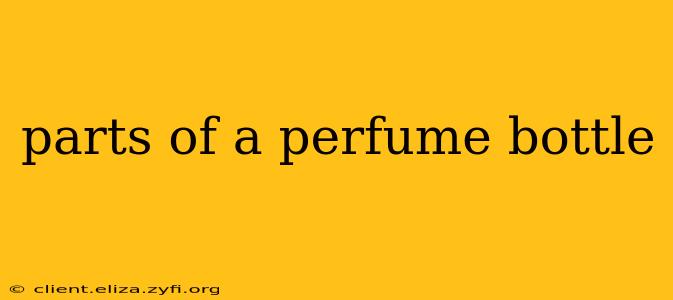Perfume bottles, beyond their aesthetic appeal, are intricate pieces of design. Understanding their components not only enhances appreciation for the artistry but also helps in choosing, storing, and even potentially repairing your favorite fragrances. This guide breaks down the key parts of a perfume bottle, exploring their functions and the variations you might encounter.
What are the main parts of a perfume bottle?
The fundamental components of a perfume bottle typically include the cap, atomizer/sprayer, collar/neck, bottle body, and the base/bottom. However, many bottles incorporate additional design elements, adding to their unique character.
1. The Cap: Protecting the Scent and Adding Style
The cap is arguably the most visually striking part of many perfume bottles. Its primary function is to seal the bottle, preventing evaporation and protecting the fragrance from air and light. Caps come in a vast array of shapes, sizes, and materials – from simple screw-on lids to elaborate, intricately designed stoppers. Some are purely decorative, while others integrate mechanisms like the sprayer.
2. The Atomizer/Sprayer: Precise Application and Elegant Diffusion
The atomizer, or sprayer, is a crucial component for many modern perfume bottles. This mechanism transforms the liquid perfume into a fine mist for even application. The quality of the sprayer can significantly impact the user experience. A well-functioning atomizer provides a consistent spray pattern, while a faulty one can lead to clogging or inconsistent dispensing. Some older or more luxurious perfumes might use different dispensing methods, like a dropper or a simple pour spout instead of a sprayer.
3. The Collar/Neck: The Transition Point
The collar, or neck, is the area connecting the bottle body to the cap or atomizer. It provides a crucial structural element and often incorporates decorative features, enhancing the overall design. The size and shape of the neck can influence the bottle's overall aesthetic and, in some cases, the type of cap or atomizer it can accommodate.
4. The Bottle Body: Shape, Size, and Material Matter
The bottle body is the main container holding the perfume. Its shape, size, and material contribute significantly to the bottle's aesthetics and functionality. Materials range from glass (the most common), to plastic, ceramic, and even metal. The shape influences not only the look but also the scent's preservation and the ease of handling.
5. The Base/Bottom: Stability and Branding
The base provides stability for the bottle and often includes branding information, such as the perfume's name, manufacturer, and sometimes the volume. Some bases are simple and functional, while others are elaborately designed to complement the overall aesthetic.
What are the different types of perfume bottle atomizers?
Perfume bottle atomizers vary significantly in design and functionality. Some common types include:
- Standard Sprayer: The most common type, offering a consistent mist.
- Fine Mist Sprayer: Delivers an exceptionally fine and delicate spray.
- Wide Sprayer: Creates a wider spray pattern, suitable for larger areas of skin.
- Pump Sprayer: Uses a pump mechanism instead of a simple trigger.
How do I clean my perfume bottle atomizer?
A clogged atomizer can significantly impact the function of your perfume bottle. Cleaning involves removing the atomizer and gently flushing it with warm water. Avoid using harsh chemicals that might damage the delicate mechanism.
Are there different types of perfume bottle caps?
Yes! Cap styles vary dramatically, ranging from simple screw-on lids to complex, hinged designs and those requiring a twisting or pulling mechanism. The choice of cap style often reflects the overall design aesthetic of the perfume bottle and brand.
This detailed exploration of perfume bottle parts provides a comprehensive understanding of these often-overlooked elements. By appreciating their design and function, we can better appreciate the artistry and engineering involved in the creation of our favorite fragrances.
